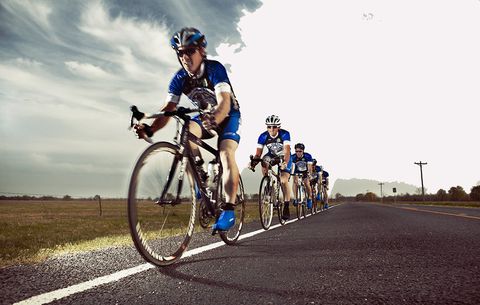
Just like doing anything with friends makes it more enjoyable, cycling with friends is usually more fun than solo. Cycling with others has many benefits, most of which I’m sure you are well aware: camaraderie, support, etc. Riding with others can help you in learning new skills, pushing yourself harder (or easier, depending on what you and your friends want), or in attaining new goals. One useful skill you should develop while riding with others is drafting and paceline riding. Drafting will enable you to save energy so that you can ride longer and faster than you can normally do by yourself. For example, there is a route I do regularly on my own and with others. I can average a good 2 mph faster with just one or two other riders, and more with a larger group.
Essentially, drafting is riding directly behind another rider. The front rider basically knocks air out of the way, creating a slipstream for the following rider. Since the following rider doesn’t have to fight the air as much as the front rider, he can keep pace with the front rider with less effort. With several riders, those further back can save as much as 25-30% energy. Pacelining is when you take turns at the front and in the draft. A paceline can be done with as few as two riders, but is more effective with a larger group. And because you can save energy most of the time, the overall speed of the group is faster since the front person can go pretty hard, knowing they can recover when the fall back into the draft.
Drafting/pacelining does take some skill and practice to do safely and effectively. It is not necessarily for everyone. If your speeds aren’t above 15 mph, it’s not even that useful unless you have a headwind. It does also require extra attention because of the heightened risk of danger and injury. In this blog, I’d like to first provide you with some mechanics for drafting, followed by a simple guideline for riding in a paceline.
Mechanics of drafting:
- Start by riding directly behind another rider with about 4 foot gap. As you get more comfortable following, ride closer to their rear wheel. Ideally, you are 6 inches to 1 foot behind the rider in front of you. The closer you are, the better the draft effect and the more energy you’ll save. However, the faster you are going, the greater the distance the effect will have. If you are going really fast, like over 30 mph, you will still feel the draft effect at a fairly large distance. Rocketing down Skyline Drive with a friend, I could feel the draft effect 10-15 feet back, as we were going over 35 mph at the time!
- Be careful not to overlap wheels with the rider in front. You don’t want him to accidentally hit your front wheel with his rear wheel if he has to swerve to avoid hitting something. If that happens, it is almost always the one in back who crashes! If you do find yourself getting too close to the rider in front of you, sit up a bit to catch a little more air. This will help you maintain the proper speed behind him. Grab a bunch of break, and you’ll find yourself suddenly several feet back and having to work harder to catch back up.
- Where to look: Don’t just look at the rear wheel of the rider in front of you! Keep your head up, watch their back, shoulders, and look ahead down the road.
- If there is a strong side wind, you may actually want to place yourself a little to the opposite side of the rider in front. E.g., if the wind is coming from the right, ride a little to the left of the rider in front. A group doing so is referred to as an echelon. This shields you from the wind more than just riding directly behind the rider.
- Keep an eye on the gearing of the rider in front of you; it will help you gauge his effort and what effort you need to stay on his wheel. Useful especially in undulating terrain
Guidelines for riding in a paceline:
- If you are new to drafting/pacelining, make sure the group is aware you are unskilled at it. If you can practice with a friend or two a few times before joining a larger group, it would be a wise idea. When you do join a new group you haven’t ridden with before (whether you are new at pacelining or not), keep to the back until you are familiar with how they run their paceline and that you are comfortable with the pace of the group.
- When on the front, keep the pace. Don’t suddenly accelerate hard. You want to keep the group going at the same speed and all together. If you suddenly up the pace, you might cause riders to fall off the back.
- Communicate with the other riders. Signal turns, etc. If you are on the front, call and point out hazards or if you have to slow. If you are at the rear, let others know if cars are overtaking (we generally yell, “Car back!”). Also, at the rear of the pack, as the leader comes back to take his place at the rear, let him know you are the last so he doesn’t end up off the back.
- If you must brake, feather the brakes. Not only will you potentially open a gap that you’ll have to close, you may cause the rider behind you to run into you if you brake hard unexpectedly. Even without incidents, if you brake suddenly, the rider behind you brakes suddenly, then you have gaps forming and the line losing its cohesion. So avoid hard braking and make micro adjustments to your speed.
- Take only as long a turn as you are comfortable with when you are on the front. Don’t feel like you have to be a superman, or that you have to take the same length of pulls (time on the front) as others. Stronger riders take longer pulls, weaker riders take shorter pulls. This allows everyone to be able to stay with the group. When you want to pull off the front, signal to the others behind and move over to let the line go by. Don’t completely stop pedaling, or you’ll find yourself off the back! If you want to skip a turn (or more), the easiest way is to stay at the back, and as the leader drifts back, let a slight gap open to the rider in front of you and let the leader know to move into that space.
- No earbuds or headphones in a paceline.
- Do not use aero bars in a paceline. If you have clip-on aero bars on your road bike, stay off them and on the hoods/drops when in a paceline. It is important to have immediate access to all over your braking/shifting, and steering controls at all times when in a paceline. (Unless you are in a team time trial – then aero bars are allowed)
These are basic guidelines, and when you join a group, you’ll learn from them if they have any specifics they would like you to know.
If you are looking for a paceline ride to join, the Winchester Wheelmen have a couple of regular rides. The Tuesday ride in Stephens City has two groups, one at a 17-19 mph pace, a faster group at 20+ mph. They have also just restarted the Thursday “Have No Mercy” ride in Berryville. This ride is for more advanced riders and tends to be quite fast, often over 22mph. The Wheelmen also do clinics from time to time on paceline riding, so keep an eye on their calendar on their website, www.winchesterwheelmen.org. Wheelmen membership is only $20/year, and a great group to ride with!



Comments are closed